Create and Use Custom Date Tables in Power BI for Date Hierarchies
By default, Power BI creates a date hierarchy based on the date data in the model. While this default hierarchy works in many cases, it can lead to unexpected results in some visualizations. Custom date tables in Power BI give you more control over date hierarchies, allowing you to customize the behavior, calculations, and formatting of date dimensions.
Instructions
Step 1: Create Date Table Using Power Query
In this example, we use Power Query to generate the date table, though you can also create it using a DAX expression in Power BI.
- From the
Homeribbon, clickGet Dataand selectBlank Query. - The Power Query Editor will open a new blank query.
- In the Power Query Editor, click
Advanced Editoron theHomeribbon, then add the following code. - Adjust the
StartDateandEndDatevariables to match the date range needed for your report. - Click
Doneto close the Advanced Editor. - After returning to the Power Query Editor, rename the table in the
Query Settingspane underPROPERTIES. I’ve named itTBL_PQ_DATE_TABLE.
let
StartDate = #date(2025, 1, 1),
EndDate = #date(2025, 12, 31),
DateList = List.Dates(
StartDate,
Number.From(EndDate) - Number.From(StartDate) + 1,
#duration(1, 0, 0, 0)
),
#"Converted to Table" = Table.FromList(
DateList,
Splitter.SplitByNothing(),
null,
null,
ExtraValues.Error
),
#"Renamed Columns" = Table.RenameColumns(#"Converted to Table", {{"Column1", "DATE"}}),
#"Add Column YEAR" = Table.AddColumn(#"Renamed Columns", "YEAR", each Date.Year([DATE])),
#"Add Column QUARTER" = Table.AddColumn(
#"Add Column YEAR",
"QUARTER",
each Date.QuarterOfYear([DATE])
),
#"Add Column MONTH" = Table.AddColumn(#"Add Column QUARTER", "MONTH", each Date.Month([DATE])),
#"Add Column DAY" = Table.AddColumn(#"Add Column MONTH", "DAY", each Date.Day([DATE])),
#"Add Column QUARTER_LABEL" = Table.AddColumn(
#"Add Column DAY",
"QUARTER_LABEL",
each "Q" & Number.ToText([QUARTER])
),
#"Add Column MONTH_LABEL" = Table.AddColumn(
#"Add Column QUARTER_LABEL",
"MONTH_LABEL",
each Date.ToText([DATE], "MMM")
),
#"Add Column DAY_LABEL" = Table.AddColumn(
#"Add Column MONTH_LABEL",
"DAY_LABEL",
each Date.ToText([DATE], "ddd")
),
#"Add Column DAY_OF_WEEK" = Table.AddColumn(
#"Add Column DAY_LABEL",
"DAY_OF_WEEK",
each Date.DayOfWeek([DATE])
),
#"Add Column YEAR_QUARTER_LABEL" = Table.AddColumn(
#"Add Column DAY_OF_WEEK",
"YEAR_QUARTER_LABEL",
each Number.ToText([YEAR]) & " " & [QUARTER_LABEL]
),
#"Add Column YEAR_MONTH_LABEL" = Table.AddColumn(
#"Add Column YEAR_QUARTER_LABEL",
"YEAR_MONTH_LABEL",
each Number.ToText([YEAR]) & " " & [MONTH_LABEL]
),
#"Add Column SORT_YEAR_QUARTER" = Table.AddColumn(
#"Add Column YEAR_MONTH_LABEL",
"SORT_YEAR_QUARTER",
each Number.ToText([YEAR]) & Text.PadStart(Number.ToText([QUARTER]), 2, "0")
),
#"Add Column SORT_YEAR_QUARTER_MONTH" = Table.AddColumn(
#"Add Column SORT_YEAR_QUARTER",
"SORT_YEAR_QUARTER_MONTH",
each [SORT_YEAR_QUARTER] & Text.PadStart(Number.ToText([MONTH]), 2, "0")
),
#"Add Column SORT_YEAR_QUARTER_MONTH_DAY" = Table.AddColumn(
#"Add Column SORT_YEAR_QUARTER_MONTH",
"SORT_YEAR_QUARTER_MONTH_DAY",
each [SORT_YEAR_QUARTER_MONTH] & Text.PadStart(Number.ToText([DAY]), 2, "0")
),
#"Changed Type" = Table.TransformColumnTypes(
#"Add Column SORT_YEAR_QUARTER_MONTH_DAY",
{
{"DATE", type date},
{"YEAR", Int64.Type},
{"QUARTER", Int64.Type},
{"MONTH", Int64.Type},
{"DAY", Int64.Type},
{"QUARTER_LABEL", type text},
{"MONTH_LABEL", type text},
{"DAY_LABEL", type text},
{"YEAR_QUARTER_LABEL", type text},
{"YEAR_MONTH_LABEL", type text},
{"SORT_YEAR_QUARTER", Int64.Type},
{"SORT_YEAR_QUARTER_MONTH", Int64.Type},
{"SORT_YEAR_QUARTER_MONTH_DAY", Int64.Type}
}
)
in
#"Changed Type"- The resulting table should appear as follows with one entry for each day in the specified date range. Adjust or add columns as needed to the table. As an example, a new column may be needed to calculate fiscal quarters that may not align to standard calendar quarters, e.g., fiscal Q1 may be October, November, and December instead of January, February, and March.
- From the
Homeribbon in the Power Query Editor, clickClose & Applyto return to Power BI Desktop.
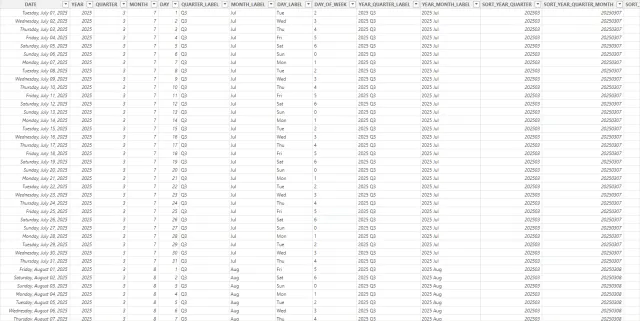
Step 2: Date Table Adjustments
Returning to the Power BI Desktop, the TBL_PQ_DATE_TABLE is now available in the Data pane.
If any fields in the TBL_PQ_DATE_TABLE are unexpectedly aggregated, be sure to set the summarization attribute to Don't summarize.
- In the
Datapane, click any field inTBL_PQ_DATE_TABLEcurrently set to summarize. - From the
Column toolsribbon setSummarizationtoDon't Summarize. - Repeat until all summarizations are removed.
For each of the text based fields, we need to set the Sort by column attribute. This informs Power BI how to correctly sort label columns in calendar order instead of alphabetically, e.g., January, February, March, etc.
- Click on each label field and set the
Sort by columnas follows. - Repeat until all label fields are configured.
QUARTER_LABELsort by columnQUARTERMONTH_LABELsort by columnMONTHDAY_LABELsort by columnDAY_OF_WEEKYEAR_QUARTER_LABELsort by columnSORT_YEAR_QUARTERYEAR_MONTH_LABELsort by columnSORT_YEAR_QUARTER_MONTH
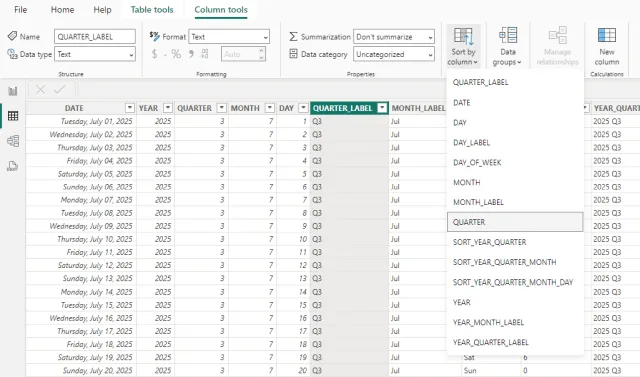
Next, we’ll create a year / quarter / month hierarchy.
- In the
Datapane, click theYEARfield inTBL_PQ_DATE_TABLE. - Click the ellipsis next to
YEARand selectCreate hierarchy. - Power BI will add a
YEAR Hierarchyunder theTBL_PQ_DATE_TABLE. - Click the ellipsis next to the
QUARTER_LABELfield and selectAdd to hierarchyand thenYEAR Hierarchy.
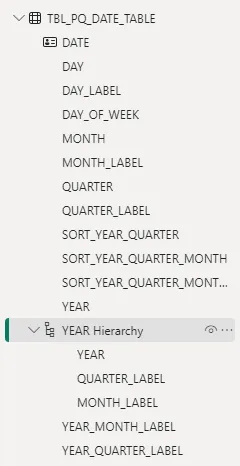
Step 3: Mark as Date Table
Now we can inform Power BI to use our custom date table.
- From the
Datapane, clickTBL_PQ_DATE_TABLE. - From the
Table toolsribbon, clickMark as date table. - The
Mark as a date tabledialog box opens. - Enable
Mark as a date table. - Verify that the
DATEfield is selected in theChoose a date columndrop-down list. - Click the
Savebutton.
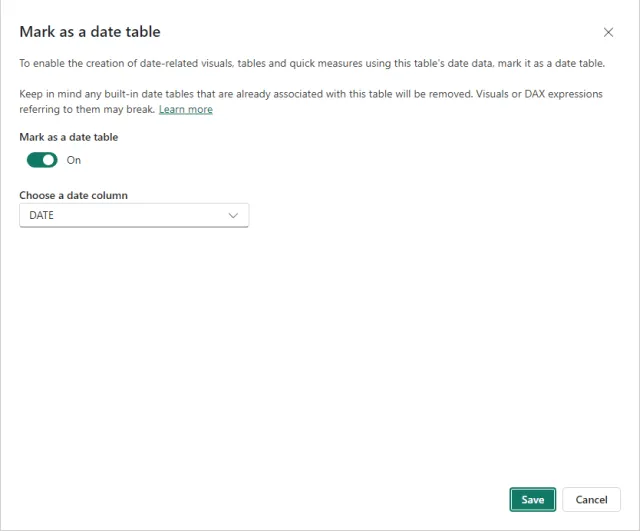
Step 4: Set Data Model Relationships
- Switch to the
Model view. - In this example, I have a simple data table called
DATAwith a date column and a currency amount column. - Create a relationship between the
DATEcolumns inTBL_PQ_DATE_TABLEand theDATAtable.
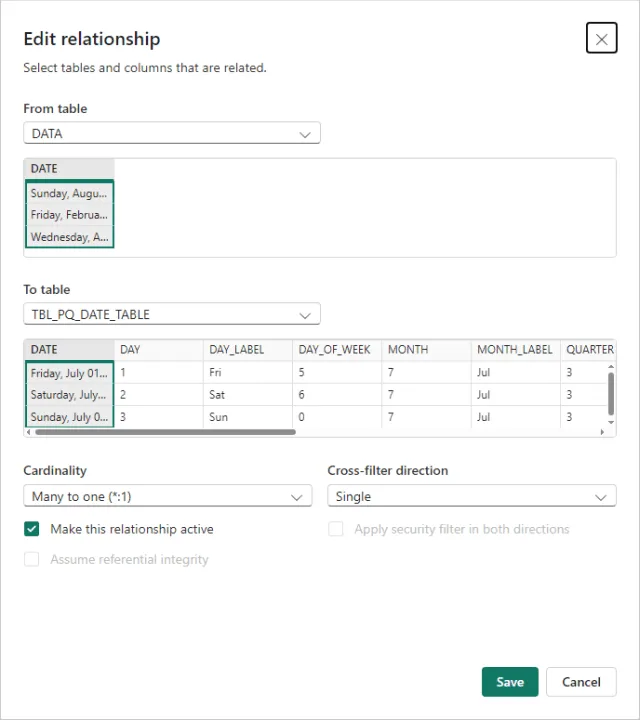
Once the relationship is established, the data model appears as follows.
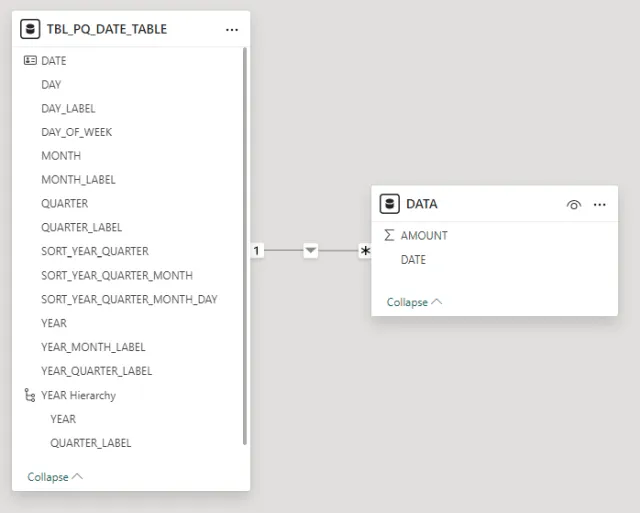
Results
- Switch to the
Report view. - To test the new date hierarchy, create a
Stacked column chartvisualization. - Set the
X-axisto theYEAR Hierarchyfrom the date tableTBL_PQ_DATE_TABLE. - Set the
Y-axistoAMOUNTfrom theDATAtable.

The visualization is created with the date hierarchy displayed correctly along the axis after expanding down to the lowest level in the hierarchy.

Summary
Creating a custom date table in Power BI gives you full control over your date hierarchy, ensuring accurate and consistent results in visualizations. By following these steps, you can tailor date dimensions to your specific needs, improving the precision and flexibility of your reports.